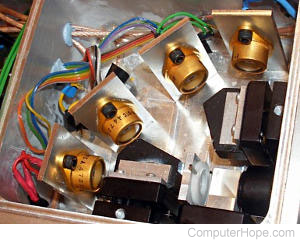Quantum cryptography

Quantum cryptography uses quantum computers to perform cryptographic tasks. It was first proposed in the early 1970s by physicist Stephen Wiesner at Columbia University and has since been developed by researchers globally.
The advantages of using a quantum computer for cryptography, rather than a classical computer, arise from the inherent properties of quantum mechanical communications. For instance, in a quantum informational system, observing data without changing it is impossible, so eavesdropping would be impossible. This type of guaranteed cryptographic secrecy is called unconditional security.
Scientists have recently constructed portable quantum computers that transmit encoded data using polarized light beams. The one shown in the image is from the QAP (Quantum Applications Project) in Europe.
